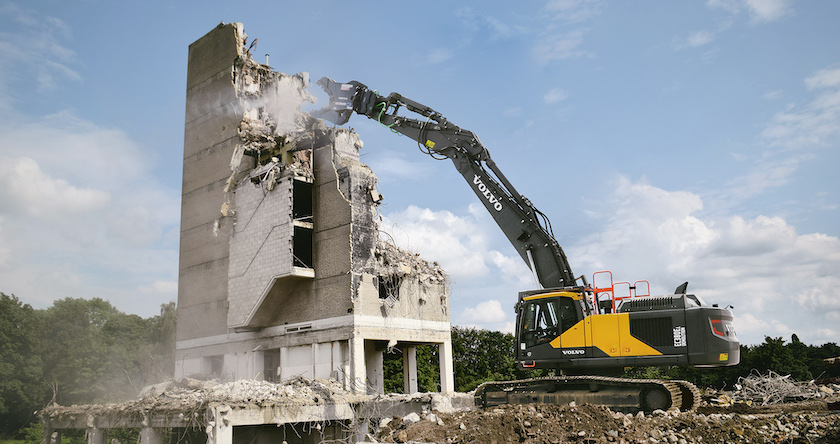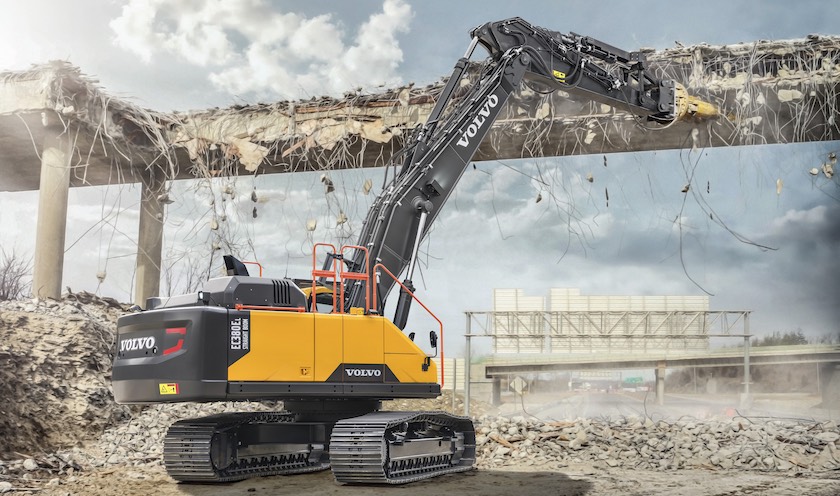Profits in demolition are oftentimes maximized by how much you can save in your day-to-day operations. Lower fuel consumption is one way to lower costs — reduced maintenance and downtime is another.
Lowering operating costs ultimately improves your machine’s total cost of ownership (TCO). These tips are designed to help you select the best demolition excavators out there to improve your TCO.
1. Identify what you have versus what you need.
Start by asking yourself what gaps you currently have in your fleet or what tasks you’re unable to do efficiently, or at all, on your projects. Whether you need high reach, secondary processing or interior demolition, these may all call for very different products.
2. Determine which excavator meets the need.
If there are multiple gaps in your lineup, you and your dealer rep should look at what product will best address your range of needs. For example, a high-reach excavator provides a lot of versatility thanks to its interchangeable boom.
As an example, a Volvo EC750E HR has two high-reach demolition boom sets and one digging boom set with an extension:
- High-reach boom with a 118-foot (36 m) max pin height while carrying a tool of up to 8,000 lbs (3,628 kg).
- High-reach boom with an 85-foot (26 m) max pin height while carrying a tool of up to 11,000 lbs (4,989 kg).
- Digging boom set with a 14.4-foot (4.4 m) extension that allows for a 59-foot (18 m) pin height.

A clean-up excavator is often considered more of a commodity and not given the same consideration as the demo machine itself, but this is a mistake. Clean-up excavators should have durable, factory-fitted features just like the others to protect your team members, operating costs and potential resale value.
3. Identify your tool size requirements.
Next, think about what type and size of tool you’ll need and which excavator can handle that tool from a weight and flow perspective. We’ve provided some primary demolition attachments and their respective considerations in this blog article.

4. Compare aftermarket versus factory-fitted machines.
If you’re using a standard excavator with aftermarket guarding and hydraulics for demolition jobs, I encourage you to look into a purpose-built machine. Factory-fitted machines can save you a lot of time, hassle and money. Consider the guarding and hydraulic options you’ll need — and if your OEM truly builds a demolition excavator, it should have those from factory.
We all know safety is the highest priority on a demolition job, and factory fitting often means a safer machine. Almost every OEM that purpose-builds their high-reach excavators includes a modular joint boom concept, but the pins that hold the joint to the boom can differ. Some use a half hook for the top pin and short pins on the bottom. However, a well-designed demolition excavator uses full-length hydraulic pins. Because they’re hydraulic, an operator can pull them out without leaving the cab, which is always preferable.
Aftermarket guarding packages can run upwards of $20,000 and involve working with a third party that will provide limited support. A purpose-built machine will come with proper guarding and full support. Factory-fitted also typically means reinforced frames, extra counterweight, a high visibility cab, optional tilting for added visibility and safety, and dust suppression.
And let’s not forget, if there’s a problem with a converted machine, it’s common for third parties to point fingers at each other — and your warranties may be voided.
5. Ensure you’re considering reliable machines with adequate support.
Be sure to discuss the long-term reliability of the excavator. Will it stand up to the intense daily demands of demolition? Many of the features I mentioned in the factory-fitted section apply here as well, but I have a couple more:
- Look for a demolition excavator with an undercarriage that provides a large footprint for stability. A retractable undercarriage that expands can provide additional stability when needed. Also, a hydraulic extendable undercarriage allows for a 360-degree working range, decreasing the time spent repositioning the machine. It can also be helpful if the undercarriage features easy-to-remove track frames and the ability to self-disassemble and reassemble for easier transportation.
- I also recommend looking for an OEM that offers support like a lifetime frame, boom and arm warranty on top of a high-quality product.

6. Determine what technology to incorporate.
There are so many useful technologies these days, so ask your rep what might be best for your specific situation. If you do your own loadout, you’ll likely want an option for load weighing. If you have a high reach, you’ll want a good camera for improved visibility. In some cases, you’ll want telematics to stay informed on machine health. And on especially dangerous sites, you may want to consider remote-controlled excavators.
Bonus tip: Don’t get hung up on an excavator’s purchase price alone. While it’s certainly a significant factor, the right investment using the advice above will get you a solid 10 years of product life or more. Remember that TCO is the number to focus on — talk these points through with your dealer and you’ll be ready to get to work.

